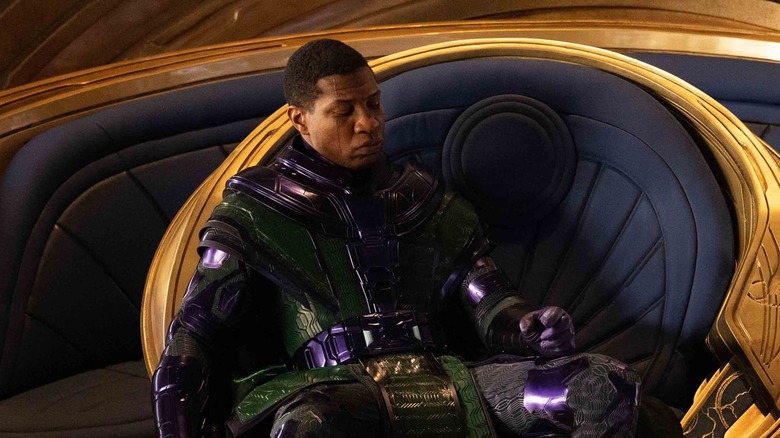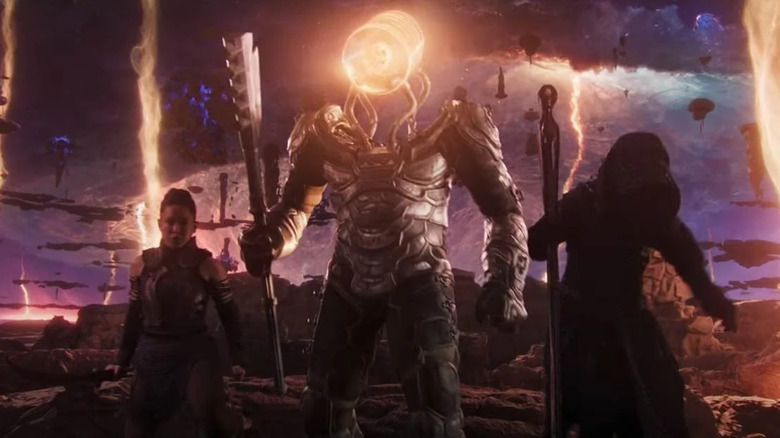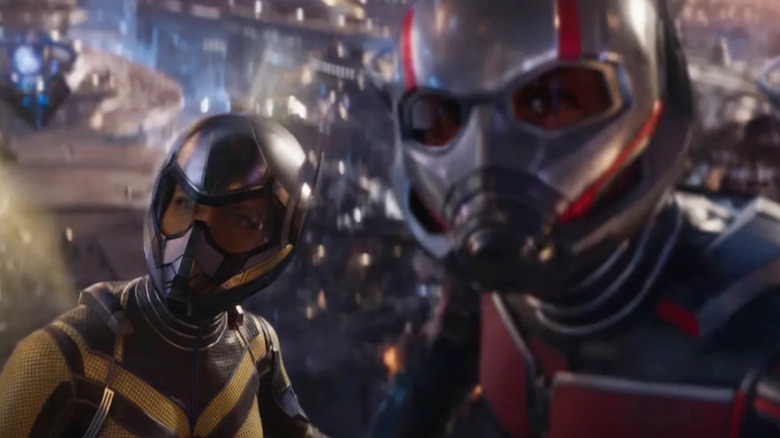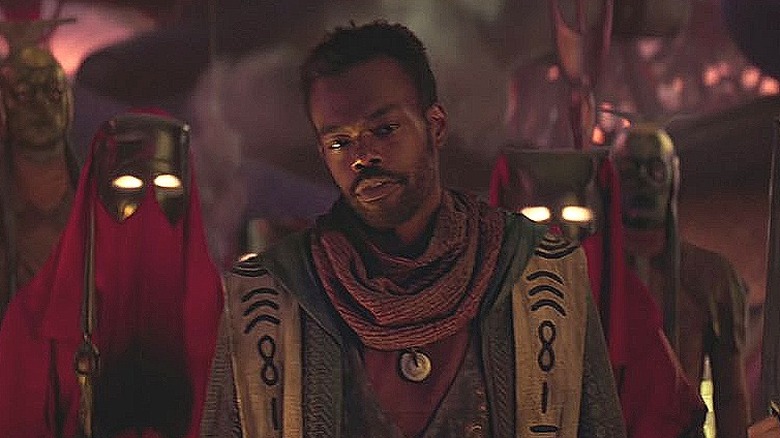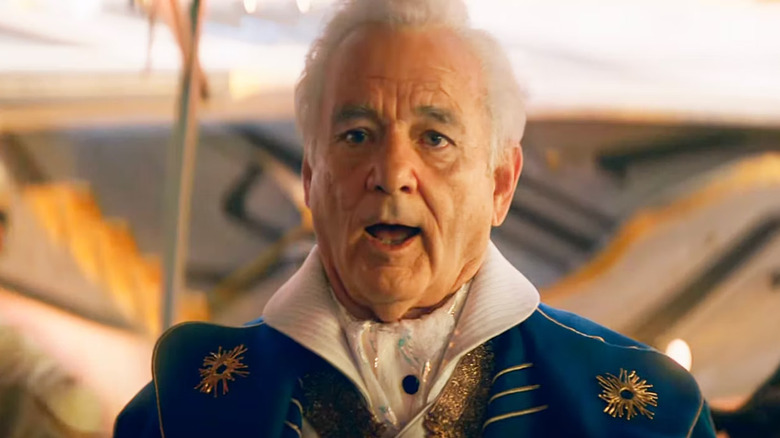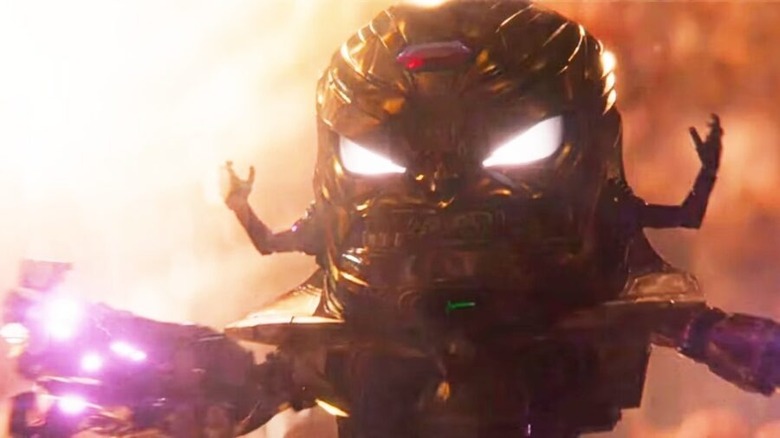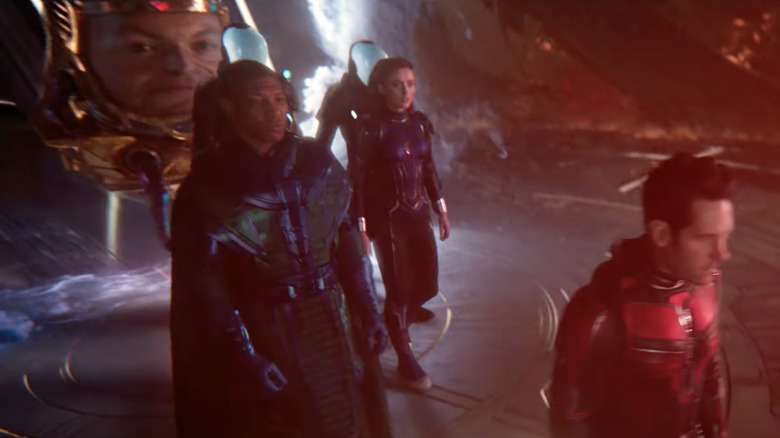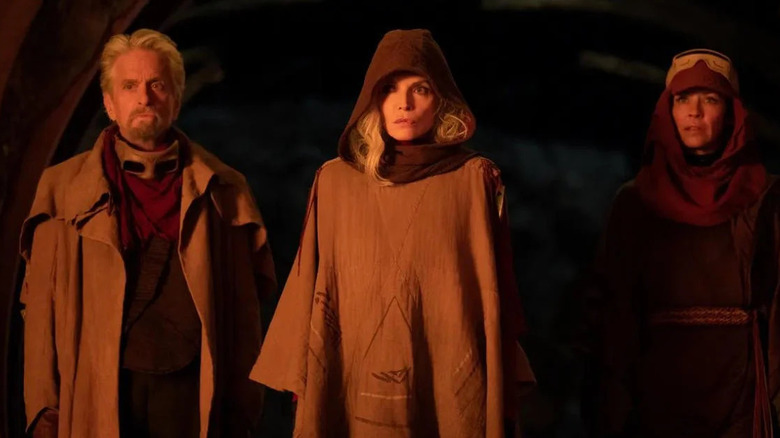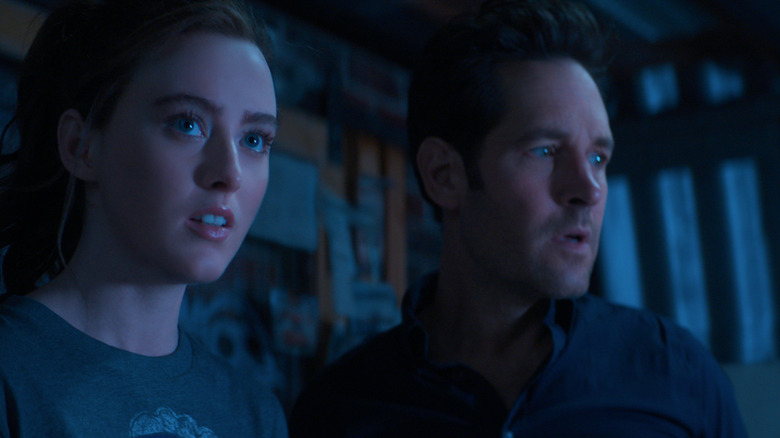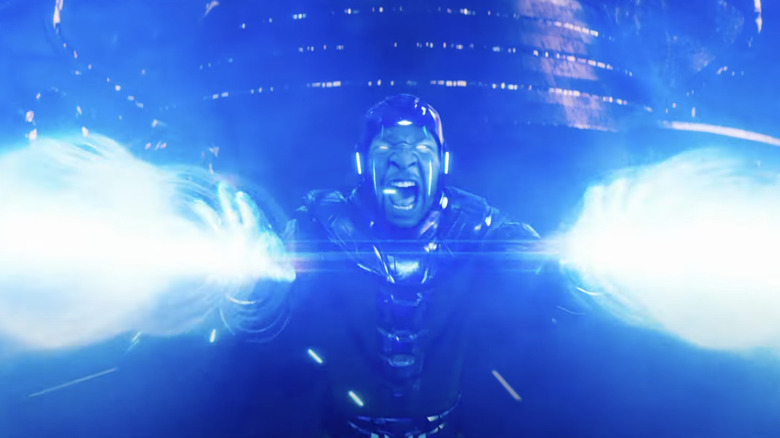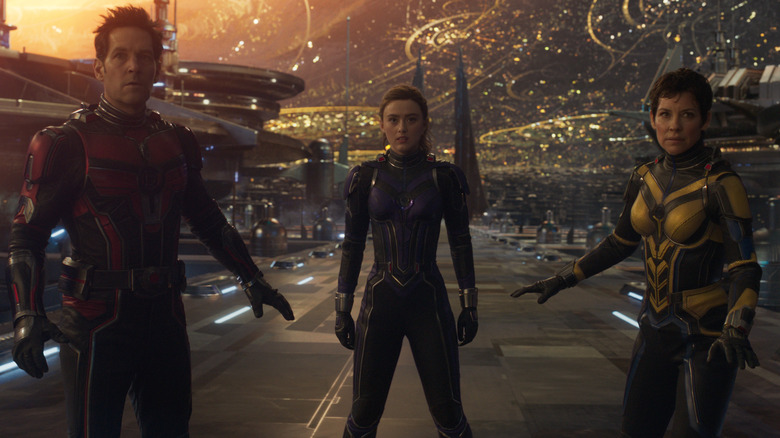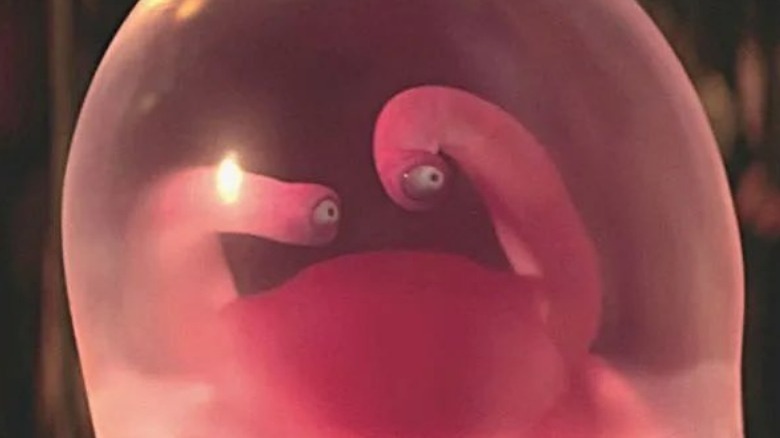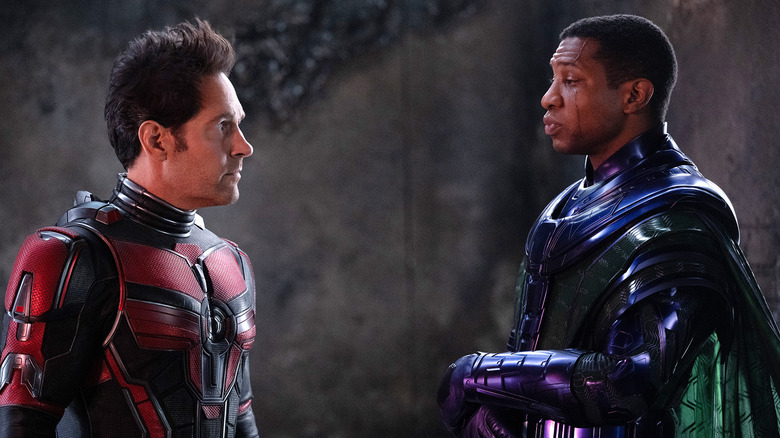Ant-Man And The Wasp: Quantumania: The 6 Best And 6 Worst Things
"Ant-Man and the Wasp: Quantumania" is the much-anticipated kick-off to the Marvel Cinematic Universe's Phase 5. After an ambitious but inconsistent Phase 4 that introduced new characters like the Eternals as well as various Disney+ TV series to the mix, Marvel fans were hoping that the third "Ant-Man" film would be a return to form. Paul Rudd remains a steady and likable presence as one of the surviving Avengers, and Jonathan Majors' Kang the Conqueror promises to once again anchor the franchise with a villain whose arc will shape the MCU's future.
The reviews are in, and though the ticket-buying public is yet to have their say, it seems that "Ant-Man and the Wasp: Quantumania" is yet another post-Infinity Saga disappointment. The third installment in director Peyton Reed's trilogy isn't a terrible movie, and "Quantumania" has some fun toys to play with in its subatomic sandbox. It just doesn't do enough with them, which makes it feel less essential than many of the rest of the MCU's offerings, even with the addition of one of Marvel's most powerful and intriguing antagonists.
"Ant-Man and the Wasp: Quantumania" is also jarringly different than the first two films in the subfranchise, despite the hidden Easter eggs that attempt to tie the three films together. Here's what worked and what didn't work about Scott Lang and the gang's unplanned trip to the Quantum Realm.
Best: The production design
The biggest difference between the other "Ant-Man" films and "Quantumania" is the setting. Before, Scott's story largely unfolded in San Francisco, with only momentary jaunts into the Quantum Realm. That meant Ant-Man found himself underneath club-goer's shoes or towering over the bay, giving us a "Honey, I Shrunk the Kids" perspective on everyday objects and places. This time, we're on Earth for mere minutes before being transported to Sub-Atomica. This hidden universe gives Peyton Reed an opportunity to fully realize his own miniature sci-fi civilization, almost as if he was building his own "Star Wars" galaxy.
The "Star Wars" comparisons don't come out of nowhere. Reed helmed Chapters 10 and 16 of "The Mandalorian" and used the same technology (the Volume) to bring the Quantum Realm to life. "Star Wars" influences are plain to see throughout the film, from the Tusken Raider-like costumes to the Cantina-like bar. While the digital backgrounds are interesting to look at and immersive at first, after a while, they begin to read like cosmic CGI soup.
The practical designs, however, are "Star Wars" level good. Highlights include the gelatinous Veb (voiced by David Dastmalchian, who also plays Kurt) and the spotlight-headed Xolum (James Cutler). Kang's ship is as cool as it needs to be, and his empire is full of flourishes that make existence in Sub-Atomica seem more fleshed out — the adorable little creatures served up in glowing cocktails are just one fantastically freaky example.
Worst: The fight choreography
Ant-Man has never been the most impressive physical specimen. Don't get us wrong — Paul Rudd looks great. Still, even the film makes a joke at his expense when Scott compares his body type to Thor's. The point is, epic battles aren't at the heart of what the "Ant-Man" movies are about. Their best set pieces — Yellowjacket getting flung into a bug zapper, the Thomas the Tank Engine fight, the giant Hello Kitty Pez dispenser, the Wasp in the restaurant kitchen — involve only a few characters and use scale to enhance the action and the comedy.
One of the most frustrating things about the Quantum Realm is that it completely undercuts Ant-Man's superpower. He, Hope, and Cassie all shrink and grow when necessary, but without the context of recognizable landscapes and props, it barely registers. Worse still is that "Ant-Man and the Wasp: Quantumania" has two extremely involved action scenes in which a whole resistance movement squares off against Kang and his minions, and neither feels the least bit climactic. In both cases, the movement of the camera is uninspired and confusing, making it hard to follow what's going on and hard to care.
The fight choreography is lackluster, too. There's a lot of running cut together with shots of the named characters standing still and taking in their surroundings as a messy, busy war is waged in the periphery. Only the final, brutal fight between Scott and Kang has weight behind it.
Best: William Jackson Harper's cameo
William Jackson Harper made a name for himself on "The Good Place" as Chidi, the deceased indecisive ethics scholar who was secretly ripped underneath his sweater vests. When news broke that he'd been cast in "Ant-Man and the Wasp: Quantumania," fans began to speculate which character from the comics he might play. Harper is smart, hilarious, and his shirtless run to the grocery store in "The Good Place" proved he had the body of a superhero, which led some observers to wonder if he could be the MCU's Reed Richards. As it turns out, Harper's character Quaz is a "Quantumania" original, and the actor's appearance in the film is basically a cameo.
Quaz is a telepathic humanoid native to the Quantum Realm and a member of the resistance movement pushing back against the authoritarian rule of Kang the Conqueror. He's tight with Veb and Jentorra (Katy O'Brian); he keeps the former from acting inappropriately and the latter from resorting to violence too quickly. Quaz uses his gift — which makes his forehead glow red — sparingly and for comedic effect. Harper gives Quaz a believable world-weariness (reading minds means he's constantly aware of how disgusting people actually are) while still being charming enough to command the audience's attention.
Harper and Rudd make for strong scene partners — we just wish we got more of him. Or better yet, that Marvel Studios hadn't wasted Harper in what's probably going to be a one-off role.
Worst: Bill Murray's cameo
Fans were equally curious about Bill Murray's first foray into the MCU. Murray's the type of comedic actor who doesn't really disappear into his roles, and the fandom was divided over whether he was a good fit for a Marvel movie. Taika Waititi pulled off a similar stunt with Jeff Goldblum in "Thor: Ragnarok," and if it was going to work with Murray, one would think the lighthearted and irreverent "Ant-Man" franchise-within-the-franchise would be his best bet.
Murray plays Krylar (or Lord Krylar, as he prefers), the governor of one of the Quantum Realm's territories. He only appears in one scene, when Janet brings her husband and daughter to a bar in Axia where she hopes to catch up with her old friend and perhaps get a lead as to Scott and Cassie's whereabouts. Krylar is the Quantum Realm's (more generic and less appealing) version of Lando Calrissian. He's the supposedly suave former love interest and political ally of Janet who, shortly after a visit to his seat of power, betrays her and her family to Kang.
Not only is Krylar paper thin as a character — neither the script nor Murray's performance goes into any detail about his and Janet's time together or why he turned — his aggro attitude is uncomfortably similar to stories that have recently come out about the actor's troublesome behavior on set. Murray's not-very-compelling cameo serves only to move the plot forward a beat.
Best: MODOK
MODOK (or the Mental Organism Designed Only for Killing) ranks among the strangest Marvel Comics characters — and that's really saying something. Fans were thrilled by the idea of a live-action MODOK, but some were decidedly less thrilled when they got their first glimpse of him in the trailer for "Ant-Man and the Wasp: Quantumania." For one thing, the MCU made a major change to the character's backstory. In the comics, MODOK is George Tarleton, a lower-level technician who mutates into a big-headed and tiny-bodied being and gets more evil from there. "Quantumania" swaps George Tarleton for Darren Cross-slash-Yellowjacket and rewrites his origin story to bring the "Ant-Man" trilogy full circle. After Scott sent a disfigured Darren into the Quantum Realm, Kang found what remained of him and repurposed him into MODOK.
The adaptation from the source material makes narrative sense, and Corey Stoll is clearly having a ball playing this new iteration of Darren, whose absurdity is dialed up to 11. With his mask on, MODOK looks satisfyingly comics-accurate. Regardless of what fans may think of Phase 4 on the whole, it embraced its 2D illustrated roots — take Scarlet Witch and Vision's Halloween costumes, for example — and the surreality of MODOK continues that positive development. Darren's death scene is also one of the few moments in "Ant-Man and the Wasp: Quantumania" that retains the first two films' oddball sense of humor.
Worst: MODOK
Nevertheless, the MCU's MODOK is half-baked. It's true that the character's popularity stems from the very fact that he's so ridiculous-looking, and there surely there will be MODOK fans who are happy with the way Darren Cross as MODOK was rendered on screen. Still, if we're being honest, the digital effects that put Corey Stoll's enlarged face into MODOK's digital frame could've used another pass or two. There's a difference between ridiculous-on-purpose and not-quite-right because of poor execution. Sadly, this depiction falls into the second category. The something's off quality makes it tough for the audience to focus on anything else whenever the character's on screen.
It was clever to cast Stoll as MODOK so as to call back to the tension between Darren, Hank, Scott, and Hope. Beyond that, Stoll is absolutely giving his all to an intimidatingly weird role. However, tonally, none of it hangs together very well. As we've touched on and as we'll discuss in more depth, "Ant-Man and the Wasp: Quantumania" is a significantly more serious movie than the two that came before it. The goofiness of MODOK's presence as well as the circumstances surrounding his last-second change of heart feel tacked on, which makes his demise (funny as it is) feel fairly inconsequential. Fans of the character will likely be upset at how quickly the MCU disposed of him.
Best: What it has to say about politics
Overall, the MCU is rather apolitical. Now and then, in films like "Captain America: Civil War" or shows like "The Falcon and the Winter Soldier," the franchise will explore ideas about, say, the rule of law or the impact of racism, but rarely with much depth. In part, that's because Marvel Studios wants to appeal to as many audience members as possible, including children, which keeps the discourse at a middle school social studies pitch. "Ant-Man and the Wasp: Quantumania" wades into politics to surprisingly effective narrative and thematic success.
When Cassie is arrested for protesting the removal of people from homeless encampments, it establishes a contrast between her activism and her celebrity father's apathy. In her world, the housing crisis has to do with the Blip, though the cost of living and the rights of refugees are salient political issues in ours. Though Cassie could be developed further as a character, her convictions — that problems exist even if they aren't happening to you and that it's never too late to do the right thing — are admirable and inspiring.
In subtle ways, "Quantumania" and the wider Kang arc is interested in the greater good versus the free will of the individual, a conundrum to which there are no easy answers. Other times, it's interested in that paradox for the purposes of a great joke. One of the film's funniest bits comes when Hank's highly evolved technocratic socialist ants (he knows socialism isn't a popular word) are pitted against Kang's dictatorial empire.
Worst: What it has to say about family
Until now, the "Ant-Man" films have been family comedies as much as superhero movies. They were relatable in how they handled Scott and Maggie's divorce and co-parenting. Scott was eager to have partial custody of his daughter, and nothing made him happier than being her hero. "Quantumania" had the potential to delve into the similarities and differences between father and daughter (who have been arrested three and four times, respectively), but it squandered it. The film missed an even bigger opportunity to make a statement about the responsibilities we have to our families versus the responsibilities we have to society at large.
It's revealed that Janet could've returned to Earth had she gone along with Kang's escape plan. Instead, once she saw what he was capable of, she chose to stop the monster instead of reuniting with her spouse and kid. Scott soon faces a similar choice, and though Cassie urges him to resist, he can't allow Kang to harm his daughter, no matter the consequences for the multiverse. The trailer for "Ant-Man and the Wasp: Quantumania" hinted that Kang might bribe Scott with a trip back in time to relive Cassie's childhood, but that plot is almost entirely missing from the theatrical release.
Bizarrely, the movie doesn't reckon with Janet's fateful decision or Scott's parental regret. The mirror situation in which both have to choose between their kid and saving the world is never revisited, and the plot wraps up uneventfully.
Best: Kang
Everyone seems to agree that "Ant-Man and the Wasp: Quantumania" has one unimpeachable bright spot — Jonathan Majors' performance as Kang the Conqueror. Majors is an up-and-coming talent who has impressed critics and audiences with star turns in films like Spike Lee's "Da 5 Bloods" and the Netflix neo-Western "The Harder They Fall." In addition to the "Ant-Man" sequel, he's getting strong buzz this year for "Creed III" as well as the gritty Sundance indie "Magazine Dreams."
MCU fans got their first dose of Majors as Kang in the season finale of "Loki," where a dynamic variant known as He Who Remains stole the show. As the MCU's future all but revolves around Kang as its new central villain, Majors was a (pardon the pun) major selling point for "Ant-Man and the Wasp: Quantumania," and he's worth the price of admission.
As Kang the Conqueror, Majors is stoic and intimidating but imbues the character with an unstable vulnerability that rumbles like a fault line underneath Kang's armored surface. At one point, Kang tells Ant-Man that he's outmatched. That feels right, even though Scott and Hope defeat this variant in the end — or so it seems. Kang is magnetic in moments big and small. If what the MCU needs is a villain to match Josh Brolin's Thanos in terms of emotional complexity and sheer presence, they've found it in Majors, who will get to act his blue-shielded face off embodying multiple facets of Kang's being going forward.
Worst: The rest of the cast
Let's get this out of the way — none of the rest of the top-billed cast is bad in "Ant-Man and the Wasp: Quantumania." Paul Rudd is as gregarious as ever, while Michelle Pfeiffer does what she can with the material she's given. But therein lies the problem. "Quantumania" has too many main characters, none of whom have enough of consequence to do. At first, their motivation is simply to find each other and get home. Then, the mission shifts to preventing Kang from escaping the Quantum Realm. How Ant-Man, the Wasp, Cassie (as either Stinger or Stature), Hank, and Janet accomplish each task is generic and forgettable.
They meet new characters, wind up in new locations, and have to innovate their way out of trouble while having heart-to-heart talks between threats. It seems as though the filmmakers' time and energy was spent on Kang and the worldbuilding, to the detriment of the title characters. Rudd's affable persona as Ant-Man is underused, as is Evangeline Lilly's ability to kick butt as the Wasp. Michael Douglas' Hank does little more than tag along. Pfeiffer's Janet keeps secrets solely to unveil exposition at the right time.
Suited up, this blended family could be the MCU's version of "The Incredibles," going to work and doing chores one minute, fighting evil the next. Instead, with a story that doesn't do justice to the characters they've built thus far, these supers feel like pieces on Marvel's game board.
Best: How weird it is
Though "Ant-Man and the Wasp: Quantumania" is more middling (and dare we say more boring) than we expected, there are moments that seem like they're from a better movie that could've been. The film is at its best when it's unapologetically weird. The creature in the mixed drink comes to mind. While another of its species got slurped up only minutes earlier by Lord Krylar, Hank's "Alice in Wonderland" like discs multiply its size, allowing it to presumably consume Lord Krylar in return. Veb's whole deal — his obsession with holes, his ooze that gives beings the ability to understand all language as their own — is fascinatingly specific and creative. So is the scene in which Scott agrees to resize Kang's energy core and ends up caught in a probability storm with infinite possible versions of himself.
Had the film committed to this vibe, which (and we mean this as a compliment) one-ups the "Star Wars" prequels in terms of imaginative peculiarity, "Quantumania" could've been something special. It's too bad that the backstories of characters like Xolum and phenomena like biological sentient buildings were under-examined and left on the table. Like "Doctor Strange in the Multiverse of Madness" before it, "Ant-Man and the Wasp: Quantumania" failed to deliver on its trippy locale and premise.
Worst: How serious it is
In retrospect, it might've been a mistake to introduce Kang (at least on the big screen) in an "Ant-Man" movie. As great as Rudd's Scott Lang and Majors' Kang are, they're two flavors that don't necessarily go together. Though the concept of an entity that exists in multiple forms throughout multiple universes and timelines is wacky in and of itself, in practice, Majors' Kang is practically Shakespearean. That doesn't mean he's without humor. Shakespeare wrote comedies, after all. It's just that Majors is playing Kang straight and to the back of the house without so much as a wink or a nod to the audience.
Ant-Man, on the other hand, has always been the MCU's source of levity. Rudd's acting style is deceptively naturalistic and subtle, and his MCU chapters have been comparatively small stakes, which allowed director Peyton Reed to spend runtime on bits that didn't matter to the rest of the franchise. "Ant-Man and the Wasp: Quantumania" is shockingly low on jokes compared to the first two films, in part because of the absence of some well-liked supporting characters. Missing from the Quantum Realm are ex-wife Maggie (Judy Greer), her husband Jim (Bobby Cannavale), and most especially, Scott's best friend and business partner Luis (Michael Peña).
Without them to bounce off of, Scott feels adrift. Maybe that's why "Ant-Man and the Wasp: Quantumania" never quite finds its footing.
